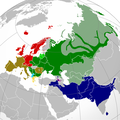Immaggine:Indo-European branches map.png

Dimenscioìn de st'anteprìmma chi: 599 × 600 pixel. Âtre resoluçioìn: 240 × 240 pixel | 479 × 480 pixel | 767 × 768 pixel | 1 023 × 1 024 pixel | 2 045 × 2 048 pixel | 2 934 × 2 938 pixel.
File òriginâle (2 934 × 2 938 pixel, dimensción do file: 2,16 MB, tîpo MIME: image/png)
Cronologîa do file
Sciàcca in sce 'n grùppo dæta/ôa pe védde comm'o l'êa o file into moménto indicòu.
| Dæta/Ôa | Miniatûa | Dimenscioìn | Uténte | Coménti | |
|---|---|---|---|---|---|
| prezénte | 05:43, 26 set 2022 |  | 2 934 × 2 938 (2,16 MB) | Alexikoua | minor fixes |
| 17:58, 30 màr 2022 |  | 2 934 × 2 938 (1,74 MB) | Whoop whoop pull up | Whoops, wrong file! | |
| 17:37, 30 màr 2022 |  | 2 048 × 2 048 (980 KB) | Whoop whoop pull up | Misc fixes (Russian minority in Svalbard & Israel, Slovenian in SE Carinthia, Greek in N Epirus, Aromanians/Megleno-Romanians, Swedish essentially extinct in Estonia, etc. | |
| 11:37, 22 dex 2021 |  | 2 934 × 2 938 (1,74 MB) | Ahmet Q. | Reverted to version as of 19:55, 23 August 2021 (UTC)seek consensus for your changes | |
| 22:40, 25 nov 2021 |  | 2 934 × 2 938 (2,16 MB) | Alexikoua | rv elimination of Greek minority in Albania | |
| 21:55, 23 agó 2021 |  | 2 934 × 2 938 (1,74 MB) | Ahmet Q. | Rv false edit summary. Overrepresentation of Greeks in Turkey, Albania and Ukraine. Unexplained removal of Romanian in Serbia. Overall deterioration of the original file. Seek consensus for your changes. | |
| 18:16, 7 agó 2021 |  | 2 934 × 2 938 (2,16 MB) | Demetrios1993 | Addition of Arbereshe linguistic minority in Sicily. Addition of Serbian, Bosnian, and Gorani linguistic minorities in Kosovo. Addition of Greek linguistic minorities in Italy, Albania, Turkey, and Ukraine. Including some other minor corrections. | |
| 19:00, 19 nov 2020 |  | 2 934 × 2 938 (1,74 MB) | Golden | update Armenian | |
| 20:42, 31 màr 2018 |  | 1 479 × 1 479 (574 KB) | Maphobbyist | Removed area that exactly corresponds to the non-Indo European Lezgi linguistic area. | |
| 23:37, 6 set 2016 |  | 1 479 × 1 479 (620 KB) | Rob984 | Georgia and Azerbaijan aren't majority multilingual. Older generations speak Russian from the Soviet era but now English is taught mainly in place of Russian. More people speak English in Finland, yet that isn't coloured. Also corrections to Celtic are... |
Utilìzzo do file
A pàgina chi de sótta a contêgne di ligàmmi a sto file chi:
Utilìzzo globâle do file
Quésto file o l'é dêuviou da 'ste âtre wiki ascì:
- Dêuviòu inte pàgine de ast.wikipedia.org chi de sótta:
- Dêuviòu inte pàgine de ban.wikipedia.org chi de sótta:
- Dêuviòu inte pàgine de be-tarask.wikipedia.org chi de sótta:
- Dêuviòu inte pàgine de be.wikipedia.org chi de sótta:
- Dêuviòu inte pàgine de bg.wikipedia.org chi de sótta:
- Dêuviòu inte pàgine de cs.wikipedia.org chi de sótta:
- Dêuviòu inte pàgine de da.wikipedia.org chi de sótta:
- Dêuviòu inte pàgine de de.wikipedia.org chi de sótta:
- Dêuviòu inte pàgine de en.wikipedia.org chi de sótta:
- Dêuviòu inte pàgine de en.wikiversity.org chi de sótta:
- Dêuviòu inte pàgine de es.wikipedia.org chi de sótta:
- Dêuviòu inte pàgine de et.wikipedia.org chi de sótta:
- Dêuviòu inte pàgine de eu.wikipedia.org chi de sótta:
- Dêuviòu inte pàgine de fa.wikipedia.org chi de sótta:
- Dêuviòu inte pàgine de fi.wikipedia.org chi de sótta:
- Dêuviòu inte pàgine de frr.wikipedia.org chi de sótta:
- Dêuviòu inte pàgine de fr.wikipedia.org chi de sótta:
- Dêuviòu inte pàgine de gl.wikipedia.org chi de sótta:
- Dêuviòu inte pàgine de gu.wikipedia.org chi de sótta:
- Dêuviòu inte pàgine de gv.wikipedia.org chi de sótta:
- Dêuviòu inte pàgine de hak.wikipedia.org chi de sótta:
- Dêuviòu inte pàgine de he.wikipedia.org chi de sótta:
- Dêuviòu inte pàgine de hy.wikipedia.org chi de sótta:
- Dêuviòu inte pàgine de hyw.wikipedia.org chi de sótta:
- Dêuviòu inte pàgine de ilo.wikipedia.org chi de sótta:
- Dêuviòu inte pàgine de incubator.wikimedia.org chi de sótta:
- Dêuviòu inte pàgine de io.wikipedia.org chi de sótta:
Véddi l'ûzo globâle de quésto file.


